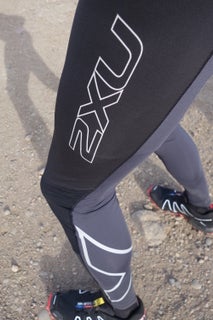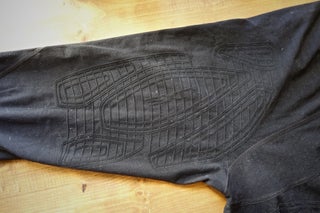Reviewed: 2XU Wind Defense and MCS Thermal Compression Tights

2XU G2 Wind Defense Thermal Compression Tights.
For me, tights are a great first layer during cold runs and cross country skiing, but I almost always throw on a shell pant over to protect my legs and knees in particular. I am also skeptical of thermal tights, preferring to go with what I know works. So I was a bit hesitant to try out two pairs of thermal tights from 2XU- the G2 Wind Defense and Thermal compression tights.
Both promised to be warmer than the standard tight. The Thermal version uses PWX Flex Thermal 70D fabric throughout to increase the warmth factor, along with extra support in key areas for increased performance. The Wind Defense pant uses a wind and water resistant fabric up front and PWX Flex 105D in the back. From my research, 2XU is the only brand that offers this type of a thermal compression tight. The goal of both is to provide the benefits of compression along with warmth and protection from the elements.
The Test

First up is the Wind Defense tight. Pulling on these tights is much like pulling on a wetsuit- you want to pull them up in stages. The fit is snug as it should be for a compression tight, but the added stiffness of the wind and water proof panel makes them harder to pull on. Once on, the fit is comfortable but slightly tighter than other compression garments I’ve worn, mostly in the quad, again mostly due to the fabric. The back panel mitigates the stiffness by being exceptionally soft and flexible. There is a zippered pocket on the right side of the back for keys or a gel.
On cold, windy runs and a few cross country skiing outings, the Wind Defense tights gained my trust. The protection from the front panels was noticeable both when the wind kicked up and during a light snow shower. As mentioned above, the protective fabric is not as flexible and has a tighter feel, especially during more dynamic motions. The extra flexibility of the back panel helps to mitigate any restriction of motion.
Next are the MCS Thermal tights, which are more similar to a standard tight just with bit thicker, softer fabric. Getting them on is easier than the Wind Defense, but not as quick as a standard compression tight. There is no zippered pocket, but there is a small pocket for a key or gel in the waistband.

As expected, without the protective fabric up front they are more flexible than the Wind Defense. For most of my runs and skis the Thermal tight provided adequate warmth and moved well with me. However, during one skate ski session with the temperature in the 20s the Thermal kept me warm enough, but I did feel some aching, especially in my knees, post ski. When I layered these under a shell pant, as I did during another cold ski outing, the Thermals were the perfect first layer.
I can’t say I felt a specific performance benefit from the MCS support in the calf and quad. They felt like many other compression tights I’ve worn, just maybe a bit tigher did feel supportive overall.
The PWX Flex Thermal fabric used on both is soft and comfortable for a compression garment. The 105D used on the back panels of the Wind Defense is noticeably softer and more flexible than the 70D used on the Thermal. This makes sense as the extra flexibility along the back helps to balance out the added stiffness of the protective fabric up front. Neither pair caused the itchy feeling, especially in the back of the knee, that I have experienced with tights in the past.
There are many similarities between these two tights. Both offer graduated compression which is claimed to help lessen muscle damage during activities and promote recovery. As someone who anecdotally believes in compression, both pairs felt felt supportive, especially on long runs. While not their primary usage, both the Wind Defense and Thermal tights are comfortable enough to slip on after a hard workout for a few hours to promote recovery. They both have reflective logos for safety and offer UPF 50+ protection.
The Verdict
Both pairs performed better than I expected and made me reconsider my thoughts about winter tights. The outer layer kept the wind and cold at bay, especially true for the Wind Defense pair, while the soft interior remained comfortable during long workouts. The element of compression is a nice performance addition. At $130 retail for each pair, they are in line with other brands.
Being so similar, the logical question is which to choose if you don’t want to shell out over $25o for tights. It’s a tough call, but I would take the Thermal tights. They are a bit more comfortable all around and offered enough warmth for me on all but the coldest days. As impressed as I was with the Wind Defense tights, for those extra cold days I can always go back to my old ways and layer a pant over them.